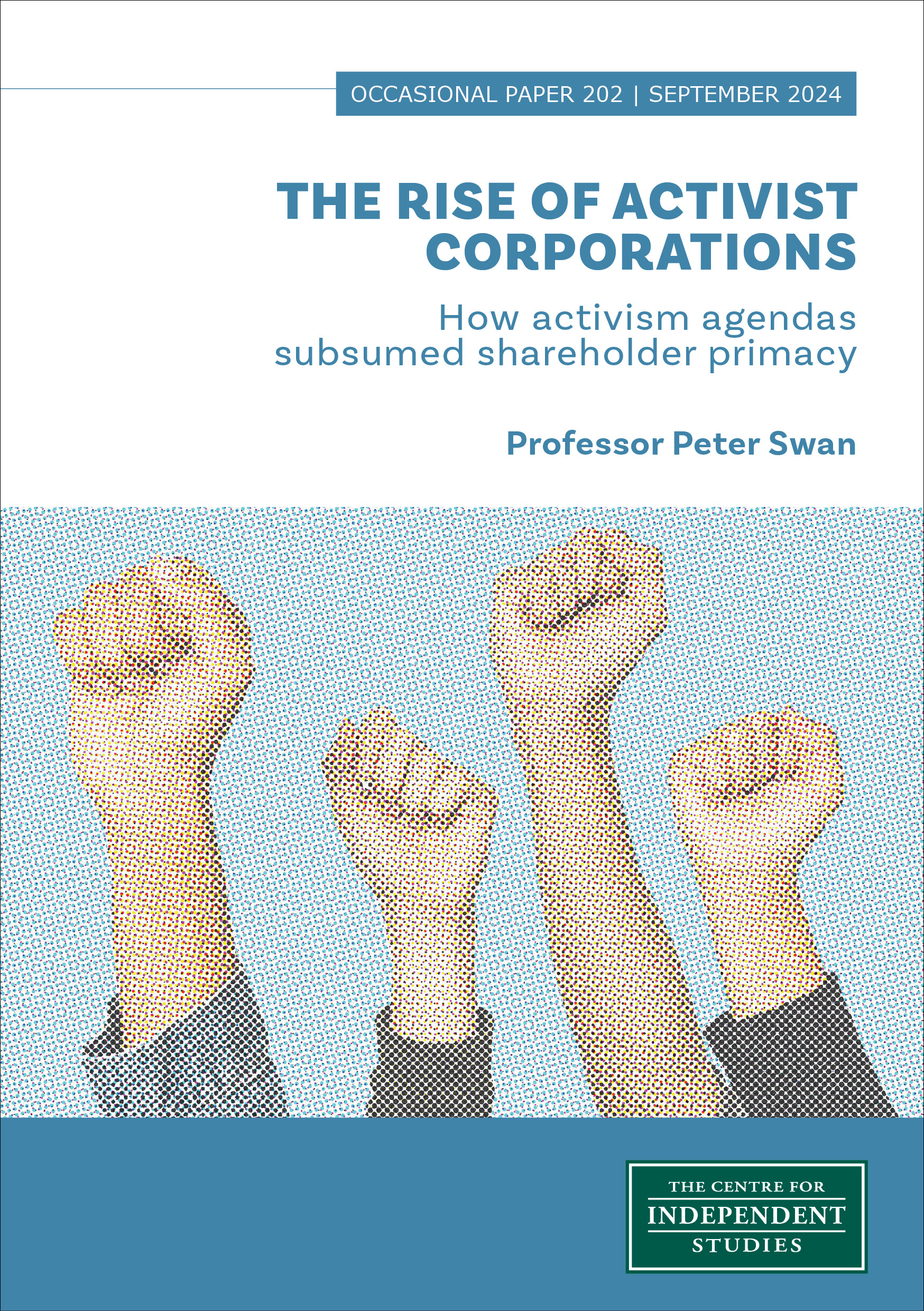
1. Introduction
Australian companies have been shifting from a purely shareholder focus to a much vaguer, less accountable, and damaging stakeholder focus for many years. One important byproduct of this decline in shareholder focus has been former shareholder resources moving into ‘social responsibility’, corporate activism, and promotion of political and popular causes that are often antithetical to the interests of corporations’ own shareholders. This has resulted in many corporations becoming ‘woke’.
A woke corporation prioritises diversity, equality, and inclusion (DEI). It hires and promotes proportionally more women and racially diverse people despite racial and gender discrimination being illegal, and with merit not being the primary consideration. It sources from ‘diverse’ suppliers despite there being cheaper and better-quality options, and it donates to progressive causes and left-wing political parties.
Its company board’s views need not be diverse, but typically 40% or more of its board will incorporate gender and/or racial diversity. Most activities are preceded by a ‘welcome to country’ ceremony in which Australians are welcomed to a country that is seemingly not theirs.
One might think that ipso facto DEI should be illegal, in that directors have a fiduciary duty towards shareholders. However, Sections 180-183 of the Corporations Act 2001 requires only that directors act in the best interests of the company and for a proper purpose. Only on some occasions must the director act specifically in the best interests of shareholders, as set out in Brunninghausen v Glavanics NSWCA (1999).
According to an advocate for corporate activism:
“Corporate activism is deeply intertwined with corporate social responsibility. Social responsibility is the responsibility a corporation has regarding any effects they cause in society with their business. Corporate activism on the other hand is perceived more as the corporation leveraging their status and power in society to shine light on issues that demand attention.” (Videolle, 2023)
Similar terms include ‘woke capitalism’, ‘woke capital’ and ‘stakeholder capitalism’. These issues include climate change and catastrophism, racial justice and Indigenous land rights, reproductive rights, immigration and open borders, LGBTQ+ rights, ESG (environmental, social, and governance), illegitimacy of Australia due to its colonial past, and gender equality including the right of biological males to self-identify as ‘female’ in female sports.
Much corporate activism is no more than ‘virtue signalling’ to demonstrate one’s moral correctness. But what starts off as virtue signalling often degenerates into hypocrisy: for example, many corporations proclaim they sit on land belonging to Indigenous or First Nations people whose rights have not been ceded, but do not offer to hand over the land or pay rent. Similarly, many refer to the looming existential threat of climate change but carry on as if the world was not about to end.
An unpleasant complementary aspect to corporate virtue signalling is the denigration of those to whom one is opposed, to shut down debate. Anyone who supported the No case in the Voice Referendum was denounced as a “racist”, Hillary Clinton (Washington Post, 2021/08/31) denounced Donald Trump’s “deplorables”, and anyone who questions the logic of climate change and net zero becomes a “climate denier” like a “holocaust denier”.
Many corporate spokesmen take the view that racism is pervasive in Australia’s society. This is the perspective of ‘critical race theory’ (CRT) and has as its foundation the idea that one cannot be racist towards a white person: “The notion of anti-white racism is based on a fundamental misunderstanding about racism” [that] “completely moves us away from the actual problems of structural and other forms of racism in this country”. (Race Discrimination Commissioner Giridharan Sivaraman).
The senior Australian Broadcasting Commission (ABC) journalist and board member, Laura Tingle, declared: “We are a racist country, let’s face it.” (Sophie Elsworth, The Australian, May 26, 2024). According to the editorial in The Australian, “CRT is marketed as an anti-racist project but its crude division between “white supremacy” and “people of colour” encourages an unhealthy and divisive fixation on race.” (Editorial, The Australian, February 04, 2022). ‘Woke’ was originally African-American vernacular for ‘staying woke’ — that is, keeping watch for racial prejudice and discrimination, police brutality, etc.
Perhaps the most famous DEI hire of all was political rather than corporate; Joe Biden’s pick of Vice President Kamala Harris was foreshadowed by his August 2019 announcement that his running mate would be “of colour and/or of different gender”. Merit never appears to have been the main consideration. Biden’s appointment of Kimberly Cheatle as head of the Secret Service seems to have been another DEI hire with Donald Trump within a centimetre of assassination and a supporter murdered (New York Post, July 20, 2024).
But in the business world, the fallouts from rabid wokeness have created a new vernacular derivative: ‘go woke, go broke’. The United States (US) brewer, Anheuser-Busch, employed trans LGBTQ+ influencer to promote its low-alcohol beer, Bud Light, in a series of advertisements that drove down sales of its once top-selling beer to the lowest level experienced since 1999 (New York Post January 12, 2024). In May 2023, the company lost $US 27 billion in market capitalisation and year-on-year sales had fallen by 30% (New York Post, December 28, 2023).
Similarly, the Disney media company has lost billions of dollars due to its attempt to foist woke messages on its subscribers (Spiked Online, February 19, 2024). “Consumers’ perceptions of our position on matters of public interest”, it said, “are risking the company’s reputation and profits.” The shaving brand, Gillette, promoted “toxic masculinity” in its advertisements to take a US $8 billion hit to Procter & Gamble’s assets (Washington Times, July 31, 2019).
Many major public companies are now closing their DEI divisions. For example, Microsoft Corporation (Daily Mail, September 9, 2024). Walmart, Netflix, and Wells Fargo all have failed DEI programs (FIG Strategy and Consulting, May 31, 2022) and big tech companies, Meta and Google are cutting DEI. There is reason to be optimistic that DEI will rapidly be extinguished at the corporate level by competition, due to the abandonment of merit as the main criterion rapidly resulting in self-destruction.
There is a reason one sees such ‘woke’ fixation in listed companies but very few examples of it in family-run firms, unincorporated business, and private equity — all of which normally have a much stronger alignment between decision makers and owners than in large corporations.
This paper puts forward a simple explanation for why it is usually especially large corporations that have become both activist for largely elite and societally damaging causes and are seriously woke. These trends are not confined to Australia but apply to the US and the United Kingdom (UK) and much of Europe as well. The reason is that nearly all corporate regulators around the world — and especially stock exchanges, whose business it is to represent the interests of the owners of corporatised businesses (namely, shareholders) — no longer solely support shareholders. Rather, their support is firmly behind entrenched management.
Yet rather than admit this, they restrict the rights of shareholders in terms of hiring their representatives. There must be a majority of part-time and outside people on the board whose major qualification is that they do not have inside knowledge of the business or a substantial shareholding. Moreover, in many jurisdictions, now including Australia, It is recommended that the board be at least 40% female but this has become a de facto quota for ASX 300 companies.
Far from providing any evidence or justification for these restrictions other than to claim without evidence that there is ‘a business case’ (See Third Edition of ASX (2014, p.11)), their only purpose seems to be to hand over shareholder wealth and control to ‘management’ which is then free to pursue woke causes at the expense of shareholders. This paper argues that this regulation of board membership weakens shareholder oversight and monitoring of managerial decision-making. The result is poorly-performing management and greater corporate activism. Since unincorporated businesses and private equity are largely unregulated and have much stronger ties between owners and managers with agency issues less severe in family-run businesses, we see activism mostly confined to large corporations with diffuse ownership in a better position to extract resources from unprotected shareholders.
In part, the distinction between listed and unlisted equity is based on the idea that shareholders suffer more because of a greater perceived distinction between ownership and control in listed companies compared to unlisted. However, this is a matter of degree. Shareholders benefit from ‘market monitoring’ by informed investors whereas unlisted companies rely on higher levels of explicit ownership incentives (Gallagher, Gardner, and Swan, 2013). The boards of private equity are typically smaller and made up of highly incentivised and knowledgeable directors with appointment based primarily on merit, not gender or ‘independence’ — i.e., outsider ignorance — as there are no controls or requirements.
Moreover, there is very little evidence of this woke phenomenon among the self-employed or small businesses as they lack the economic rents created by large, incorporated businesses to exploit and interfere with governance choices. This paper later provides evidence that private equity is growing 12 times faster than public equity in Australia. In addition, public equity is largely in retreat around the world, and this will limit the growth of corporate activism in the future. Hence, there is reason to be optimistic about the future.
Of course, there have been other explanations provided for corporate activism, but one most often given is narcissistic CEOs who seem altruistic but have self-serving motives (Wright, 2023, p.266). The conservative former Biotech CEO, Vivek Ramaswamy, wrote (Wright, 2023, p.267): “Here’s what the sincere guys miss: when they create a system in which business leaders decide moral questions, they open the floodgates for all their unscrupulous colleagues to abuse that newfound power”. Of course, there are undoubtedly personal motivations that explain why some CEOs are more willing to lecture the public on how it should think than are others, but such theories do not explain why it is largely CEOs of sizeable, listed corporations who speak out rather than the leaders of family or unlisted businesses.
2. Why Shareholder, not Stakeholder, Primacy is Required
The main excuse corporations adopt for their woke stance is their ESG standards. Garvey et al. (2017) find firms that disclose the widest range of socially responsible policies such as signing the UN Global Compact, disclosing “family friendly” employment, etc., “are more likely to experience ethics controversies and adverse regulatory actions in the future.” Hence ESG appears as no more than cover for damaging environmental actions; just as climate catastrophism provides cover for billionaires to destroy much highly-productive arable land with industrial and short-lived solar farms, 280-metre-high windmills made from toxic materials that cannot be recycled or reprocessed except at enormous cost, and giant powerlines that make agriculture beneath them very difficult. In addition, when a hailstorm destroys a 10,000-hectare solar farm or when the toxic glass panels and windmills fail after 15 or 20 years, they could remain as a permanent blight on the landscape.
Why the current emphasis on stakeholders rather than shareholders? Should companies be governing on behalf of a wide range of interests other than shareholders as the Australian Institute of Company Directors (AICD), essentially a trade union for directors, has argued for decades?[1] The AICD applauds emeritus law professor Ian Ramsay’s self-contradictory statement: “relentless pursuit of profit maximisation, linked to executive incentives, has led to excessive risk taking in some organisations, poor sustainability and loss of wealth for shareholders” (AICD, September 19, 2019), as if looking after the interests of shareholders means actually destroying their wealth.
Ramsay confuses the ill-informed and excessive allocation of options to executives, which is often undertaken by boards dominated by ‘independent’ directors, with shareholder primacy (see Leisen and Swan, 2024). What is distinctive about all these groups — customers, suppliers, employees, debtholders (including banks), etc. — other than shareholders, is that their interests are all contractually protected other than by management.
Customers can go elsewhere if the company fails to deliver, the supply chain is driven by contractual obligations, employees (including managers) are protected by contractual terms and workplace laws, debtholders can wind up the company and claim any assets notionally owned by shareholders. Only shareholders are ‘residual claimants’ gaining whatever is left over, if anything, after suppliers, employees, and debtholders, together with every other input into the firm, have been rewarded. This is why shareholders in the firm are deemed to be the ‘principals’ and the CEO and management the ‘agents’ who act on behalf of the principals. But unfortunately, while management still works for shareholders, it now prioritises the interests of many other groups as well — often at the expense of shareholders.
The most cogent arguments against companies becoming corporate activists and pushing social messages to employees, customers, and society at large was from Milton Friedman (New York Times, September 13, 1970). He pointed out that businessmen claim corporations have a “social responsibility” to promote the causes of the day. Today, these causes are many and varied but the main one is to ‘save the planet’ by promoting climate catastrophism and ‘net zero emissions by 2050’. A corporation is a purely artificial legal structure that has no responsibilities as such, even though it can be sued for defamation, and an executive is responsible to his employer who is ultimately the owner of the business: namely, shareholders.
In a private capacity and utilising his own private wealth, an executive can support and fund any ‘social cause’ of his own choosing, but this does not give him the right to take other people’s money, namely shareholder funds, to do so. This is of course a denial of capitalism, as capitalism requires a return to those who provide capital. It is also a well-trodden path towards anti-capitalist views that can ultimately lead to various forms of left-wing dogma such as new varieties of socialism posing as a social agenda (New York Times, September 13, 1970).
In Capitalism and Freedom (1962) Friedman argues “there is one and only one social responsibility of business — to use its resources and engage in activities designed to increase its profits so long as it stays within the rules of the game, which is to say, engages in open and free competition without deception or fraud”. In his article (New York Times, September 13, 1970) he expresses the same view slightly differently: “… while conforming to the basic rules of the society, both those embodied in law and those embodied in ethical custom,” which seems to allow departure from a shareholder focus so long as it is “embodied in ethical custom” but there is no further mention or definition of “ethical custom”. There is no reason to believe any of the causes taken up by corporations fall into this category.
Based on either statement, shareholders are content to have the corporation make as much profit for the shareholder’s benefit within the law, with the shareholder then free to support any social cause of his own choosing. Friedman argues that the executive who extracts funds from shareholders and diverts them to mostly socialistic causes is essentially usurping the exclusive right of government to tax and spend, depriving individuals of freedom, and undermining the democratic system. Much of what comes out of business-speak is the subversive idea that pursuit of profits is wicked and immoral and must be curbed and controlled by external forces. But these external forces are not the benevolent administrators envisioned by socially conscious corporations but rather the iron fist of government bureaucrats.
3. What is wrong with the ASX Governance Council?
One possible explanation for why large, listed companies are going woke is that activist corporations think they are acting in the interests of their own shareholders when they act on behalf of minority groups. (Of course, being an artificial legal structure, corporations cannot think at all, although their managers can.) However, this explanation is not plausible, as most activism directly hurts shareholders because it is undertaken at their expense and there is little evidence the minority groups genuinely benefit.
Corporations that actively intervene to supposedly assist minority groups claim to be assisting sizeable portions of society, but a 2022 opinion poll conducted by YouGov showed that Americans at least vastly overestimate the size of minority groups by a factor of 10 to 35-fold (The Spectator Australia, February 18, 2023).
The main reason companies barely recognise the rights of shareholders and thus embark on corporate activism, which is entirely antithetical to the interests of shareholders, is because regulators — and, in particular, stock exchanges — have helped to deprive shareholders of appropriate representation in the boardroom. This has made it almost impossible for company boards to act as effective agents for shareholders. The recommendations of the Australian Securities Exchange (ASX) Corporate Governance Committee, which has been formulating rules since 2002, is a case in point.
The committee is comprised of 19 organisations representing super funds, directors, and a variety of other lobby groups nearly all antithetical to shareholders. Only one allegedly represents shareholders, but their views and actions usually seem contrary to shareholder interests. The most powerful and woke of these organisations is the Australian Institute of Company Directors (AICD) which claims to be the largest director membership organisation in the world. Naturally, its aim is to increase the power and influence of directors, but such power and influence comes at the expense of shareholders.
On an ‘if not, why not’ basis, Australian boards are recommended to have a majority of ‘independent’ directors who are perceived to have nothing that could materially interfere with the independent exercise of their judgement. According to the ASX (2019, p.15), the justification is:
“Having a majority of independent directors makes it harder for any individual or small group of individuals to dominate the board’s decision-making and maximises the likelihood that the decisions of the board will reflect the best interests of the entity as a whole…”
No mention is made as to the ability of these part-time appointees for whom the main consideration mandating their appointment is ignorance, that is, their initial lack of any background or inside knowledge of the company. Mostly they own negligible shares, or at least negligible compared with the CEO, other executives, and significant shareholders. Hence their alignment with shareholders is low, leaving them with very little motivation to act on behalf of shareholder interests other than perhaps their own reputations.
Candidates on the company slate get elected. If questioning management gets you removed from the slate, the chances of re-election are poor. This factor being well understood, very few independent directors speak up to take a critical stance against management. This lack of incentive combined with a severe informational deficiency compared with an executive, a substantial shareholder, or even a former and now retired CEO, does not auger well for company performance.
Being exceptionally busy while serving on multiple boards is not likely to assist company performance, either. Today most boards are made up almost entirely of such part-time, outside (non-executive) directors other than the chief executive officer (CEO) (see Leisen and Swan, 2024, for US evidence). Most independent directors are fine, upright people with integrity and a strong desire to improve company performance. Many are highly distinguished in their own field. However, this does not mean they will necessarily outperform current or former insiders or substantial shareholders, nor does it justify the requirement that they make up a majority of overall directorships.
There are a variety of reasons why a director may fail to qualify as ‘independent’. Strangely, and prominent among these, are significant shareholders (10% shareholders in the 2024 draft of ASX Corporate Governance Principles) or anyone associated with such a person. Of course, since the time of Adam Smith, it is fundamental that the basis of successful capitalism is alignment between shareholders and management. While the purpose of exchanges such as the ASX is to promote capitalism via listing rules and share exchange, it is remarkable that the ASX should go out of its way to promote the very antithesis of capitalism by attempting to (and largely succeeding to) remove significant shareholders from boards, along with former experienced and knowledgeable CEOs. It is noted below that the ASX is a victim of its own board edicts.
The main group to be displaced on boards by non-executive ‘independent’ directors were executives; with normally only one executive, namely the CEO, remaining. The chief marketing officer, the chief financial officer, etc. were relegated solely to the executive committee. Much of the very limited time ‘independent’ directors spend with the company is taken up serving on various board subcommittees where they have very little, if any, contact with executives and thus become more out of touch with the corporation (see Adams, Ragunathan, and Tumarkin, 2021).
Jensen (1993), Adams and Ferriera (2007), and Harris and Raviv (2008) all point out that full-time executives have a monopoly of firm-specific information. Hence, boards are likely to be ineffective as monitors of management as independent directors may well find themselves subservient to executive directors who are reluctant to pass on information. Cohen, Frazzini, and Malloy (2012) find that boards appoint independent directors who are little more than cheerleaders, with such firms increasing earnings management and CEO pay following such appointments.
Fracassi and Tate (2012) provide evidence that powerful CEOs appoint external directors with strong network links to the CEO. Ravina and Sapienza (2010) examine the relative trading performance of insiders (executives) and outsiders (independents) to find that independent directors earn less on their trades than executives. When insiders purchase shares and particularly when firm performance is poor, the gap widens. These findings indicate that executives do not always pass on relevant information to independent directors who are thus less informed than insiders.
Linck, Netter, and Yang (2008) find that firms more dependent on informed advice —such as firms with high growth opportunities, high R&D expenditures, and high stock return volatility — tend to have smaller and less independent boards, while large firms employ larger and more independent boards. One explanation for this is that large firms benefit more from monitoring. Another is that being large and highly visible, they are more subject to popular fads including ‘group think’ and media pressure. Duchin, Matsusaka, and Ozbas (2010) find that when it is easy to obtain information about a company, ‘independents’ add value, but when it is not the opposite holds.
Swan (2014) finds that following the ASX requirement of firms to have 50% or more independent directors, many outside directors other than ‘independents’ left the boards of large Australian companies. These were particularly knowledgeable, noncompliant, former CEOs and significant shareholders or their representatives. These departures led to a $85 billion fall in company values based on the impact on what is known as the Tobin Q ratio, that is the ratio of the market value of all assets to their book value. The same departures removed informed scrutiny of the CEO, enabling CEO pay to rise by $18 million across the largest companies. The presence of incentivised outside directors put pressure on fees paid to ‘independent’ and other outside directors. With the departure of these directors, fees collectively rose by over $2 million (Swan 2014).
Company senior executives and insiders on boards are full-time, knowledgeable about the company, its business model, and how things get done, usually work closely with the CEO and thus are aware of both strengths and, particularly, weaknesses. Their replacement by ‘independent’ part-time outsiders who are far less knowledgeable about CEO performance leads to weaker scrutiny of the CEO’s performance. Since executives are far more shareholder incentivised than are ‘independent’ directors, monitoring of the CEO and management declines following the exit of senior executives from the board with their replacement by ‘independent’ directors.
A recent paper by Leisen and Swan (2024) is based on the idea that bank incentives differ markedly from non-bank incentives because risk plays a major role in banks. The gambling ratio (option volatility [Vega] relative to shareholder alignment [Delta]) captures risk incentives relative to effort incentives. Increasing the gambling ratio — that is, providing what amount to excessive option-based CEO incentives relative to share-based incentives — increases bank and subprime risks while decreasing bank profitability.
These kinds of incentives increase the value of CEO option payouts when share price volatility is raised. By taking on more subprime risk in the run-up to the Subprime and Global Financial Crisis, for example, bank CEOs enriched themselves. Hence US bank CEOs were rewarded for taking subprime gambles. In the period leading up to the subprime crisis, the growth in the gambling ratio was assisted by adding additional outsiders (‘independents’) to bank boards, with the proportion rising from 50% to 80% in just a few years. Exchange recommendations for a majority of outside directors in 1998 followed by compulsion in the aftermath of Sarbanes-Oxley were augmented via peer pressure in the run-up to crisis. Excessive option grants came about because ‘independent’ directors failed to understand they were toxic for the bank’s performance since they incentivised recipients to gamble rather than align the incentives of managers and shareholders.
The Third Edition of ASX (2014, p.11) claims: “Research has shown that increased gender diversity on boards is associated with better financial performance.” Their justification is Catalyst (October 2011). However, Catalyst is not an academic research-based organisation but rather a lobby group whose aim is to “help build workplaces that work for women.” Nor is their Report a peer-reviewed article. While the 2010 Second Edition of the Governance Council study also provides Catalyst as a justification, neither the Fourth Edition nor the draft (2024) Fifth Edition even provides any justification for gender quotas based on business performance.
Perhaps the dropping of all justifications for gender quotas is because there are no credible justifications. Renée Adams (2016) adds a simple firm size control to the sample used by the 2007 version of the Catalyst report to find that there is no longer any relationship between gender and firm performance once she adds the omitted variable. This is because larger companies tend to perform better, and greater public scrutiny gives rise to a greater proportion of females on the board. Hence, she finds there is a correlation, but no causal relationship, between firm performance and women on boards.
Similarly, the McKinsey and Co. (2015) study claims to find a positive correlation between the proportion of women on boards and accounting performance while excluding any control for firm size. But as Mackintosh in the WSJ, June 28, 2024, points out, the study does not even reveal the companies in their sample, let alone any indication of causation.
In the belief that greater diversity improves board performance, and as part of the ESG standards, the latest Fifth Edition of ASX (2024) recommends for all ASX 300 listed entities an increase in the proportion of female directors from at least 30% to 40% or more. This recommendation is made despite the Sex Discrimination Act 1984 banning workforce discrimination based on gender. For large ASX companies, the proportion of females on the board has risen from 8.3% to 34.7% in just the last 15 years. It is not that more women on boards is necessarily bad or that they are not good directors, rather it is the mechanism by which this has come about, namely the recommending of what amount to de facto quotas, which seems to do the damage. Not only does this represent further intrusion by regulators into the right of shareholders to choose their representatives, but it does nothing to improve corporate governance and stock market performance.
My own research finds females are better than males at stock investing (Swan, 2017). This is in part because they are more ‘contrarian’, that is, only buying when prices are falling and selling when prices are rising, indicating they are more informed. They are also far less inclined to trade as they are prepared to wait for a profit opportunity. The contribution by Renée Adams and Daniel Ferreira (2009) was a classic demonstration that diversity in the form of more women on boards appeared to do little, if anything, for firm performance other than improve board attendance.
Ken Ahern and Amy Dittmar (2012) analyse a 2003 draconian law that mandated a rise in the proportion of women on Norwegian boards from the existing level of 9% to a minimum of 40%. They establish a significant fall in market value (Tobin’s Q), and a more significant decline for firms that initially had no female directors, compared with those with at least one, with a decline of 3.5%. The quota “led firms to grow in size, make more acquisitions, and realise worse accounting returns.” In the Australian situation, event studies indicating a decline in market capitalisation were carried out at the time and showed that very few new female directors were appointed, with existing female board appointees simply sitting on more boards and becoming a lot busier.
Bøhren and Staubo (2016) found the same Norwegian law raised the proportion of ‘independent’ directors from 46% to 67%, since the majority of women added to boards were part-time outside directors with no association with the company. They also found a sizeable decline in firm value, a 40% decline in the number of male board members, and a change in status of 50% of companies so they no longer had to comply with the draconian impost. Companies delisted to become either private or shifted their listing to other exchanges, leading to a sizeable decline in the number of listed Norwegian companies. The study found small, young, unlisted, and profitable firms with strong owners and low gender diversity on the board were the wors- affected by the female board impact. Bertrand, Black, Jensen, and Lleras-Muney (2019) find “no robust evidence that the reform benefited the larger set of women employed in the companies subject to the quota”. Moreover, it had “very little discernible impact on women in business beyond its direct effect on the women who made it into boardrooms”,
The most recent analysis of the issue is a very thorough review by Bayly, Breunig and Wokker (2024) who attempt to replicate as many articles as they can on whether females on boards contribute to firm performance. They utilise a remarkable 5,400 regressions. While the vast majority are insignificant, for the remainer there are far more negative rather than positive findings. For Australia, they construct a comprehensive database to conclude that there is no strong evidence female board membership affects financial performance.
We have seen how the ASX’s own Corporate Governance Council promotes exceedingly bad governance requirements on its own listed companies with no justification or research to back up these requirements and despite being the listing authority. Moreover, ASX-listed companies are required to meet onerous and stringent continuous disclosure requirements that cannot mislead or deceive the market.
However, the corporate regulator, the Australian Securities & Investments Commission (ASIC), has now — and unusually — charged the entire ASX as a listed company (rather than naming any individual perpetrators) in the Federal Court for breaking its own and ASIC’s disclosure requirements.
In August 2024, ASIC claimed statements made by the ASX to investors in February 2022 were “misleading and deceptive” around how the Clearing House Electronic Subregister System (CHESS) replacement project was tracking (The Australian, August 14, 2024). The failed project led to $255 million in write-downs and was scrapped toward the end of 2022. There were numerous red flags available to board members at the time. Joseph Longo, the Chair of ASIC, said: “Australian investors, consumers and businesses expect ASX, as the listing authority and as the listed entity itself, to uphold the highest standards of integrity and corporate governance”. If the entire ASX board is found culpable, significant changes will need to be made.
Already, the ASX board chair has announced he is stepping down. Naturally, the board follows the ASX’s own rules with nine members at the last AGM, of whom four are female, including the CEO, and eight are independent. This seems to be board failure writ large, with the ASX affected by a weak board that appears to be no more than a cheer squad for management. The penalty could be hundreds of millions of dollars (The Australian, August 14, 2024). Criticism of ASX’s distributed ledger blockchain system upgrade to CHESS has extended back to 2016 with ASIC aware of serious problems as early as 2020 (The Australian, August 15, 2024).
4. Conclusions
Nearly all the pressure for firms to indulge in corporate activism — and thus relegate shareholders to merely being one of many stakeholders — applies only to listed companies. This is true in Australia due to the corporate ‘engineering’ by the ASX on independent directors, gender diversity, etc., and following Sarbanes Oxley and the US listing requirement to have a majority of independent directors. However, it exempts private equity and all unlisted firms.
To escape existential threats due to disenfranchised shareholders, listed companies can be acquired by private equity. Doidge, Karolyi, and Stulz (2017) report a sizeable decline in the number of listed US companies with mergers leading to the fewer remaining companies becoming much larger. Their findings are consistent with a sizeable decline in the net benefits of being listed over the last 20 or more years. The Reserve Bank of Australia reports that Australian private equity funds raised $11.7 billion in capital in 2022 — 12 times the value of capital raisings on the ASX (Harris and Chow, April 18, 2024). The very strong regulatory and ASX thrust to limit shareholder choice when it comes to the board determination for listed companies seems to have helped promote a relative decline in corporate capital raisings and provided a huge boost to private equity capital raisings.
The ASX has embarked on a wilful path of self-destruction, commencing in 2002 with its corporate governance interventions — which have the effect of depriving shareholders of sovereignty. Could there be any beneficial outcome from this push by corporate regulators and exchanges to weaken shareholders of their ability to monitor management, and thus ameliorate mismanagement and wokeness performed at the expense of shareholders?
As we have seen, these actions are limiting both the size and growth of the corporate sector and are thus entirely self-destructive. Moreover, they also limit the scope for future corporate activism. Hence, indirectly, one might say there is a benefit to the public from revealing self-destructive behaviour that is fortunately confined to one sector rather than to all firms. We have seen how many companies who adopted corporate activism lost tens of billions of dollars, although they did not actually ‘go broke’. Since the careers of the instigators were either destroyed or damaged, there is also a self-correcting mechanism in place that limits extreme wokeness and provides a message to would-be imitators.
ESG funds have been heavily promoted in Australia but not all have performed well. For example, the S&P Global Clean Energy Select Index Fund fell 27% in 2023-24 and IShares Global Green Fund fell 28%, while non ESG funds such as MVIS Australia Equal Weight Index rose 8% (Moran, July 6, 2024). In 2023-24, all top 11 high-performing super funds with returns between 10% and 11.8% either claimed they had no fossil fuel companies or avoided them. However, in reality, nine of them included such companies with weights between 7 % and 11%. The two funds that genuinely excluded fossil fuel companies had the lowest five-year returns of 4.7% and 5.5% (Moran, July 6, 2024).
ASIC has finally succeeded in convicting a major superannuation fund manager, Mercer, for ‘greenwashing’ — with a $11.3 million fine. The court found Mercer’s claim that seven ‘Sustainable Plus’ investment options excluded investments in companies involved in the production or sale of alcohol, gambling and fossil fuels was false (The Australian, September 9, 2024).
Australian corporations have progressively become more ‘woke’ and pursued more activist causes such as the Voice, net zero and climate alarmism, support for antisemitism, Black Lives Matter, LGBTQ+ rights, critical race theory, rights of self-declared women to compete in female sports, open borders, quotas for female employees, denunciation of western civilisation and our colonial past, and many others, often very bizarre.
Support for such causes is usually at a sizeable cost to shareholders with most companies critical of shareholder rights but supportive of stakeholder rights. While much of this activism might be seen as a normally failed attempt to curry favour with governments of the day promoting bizarre ideas such as net zero, governments can change quite rapidly or drop one fad in favour of another. That is, wokeness and activism rarely, if ever, pay off for shareholders.
A far more plausible explanation set out in this paper is that many governments and (particularly) stock exchanges, especially the ASX, have set out to correct what they perceived were defective boards but in doing so have perhaps unintentionally deprived shareholders of their rights and thus weakened company governance. This has been especially so in denigrating substantial shareholders, setting quotas for ‘independent’ outside directors, and imposing increasingly severe de facto quotas for women on boards.
As the recent action by ASIC against the ASX illustrates, the ASX’s own board has entirely failed ASX shareholders. Rarely do exchanges attempt to provide any justification for their high-handed dictates, or when they do, the justification is withdrawn when it is found to be spurious — but the policy remains.
While stock exchanges are supposedly facilitators of shareholder trading, M&A, and new company formation and investment via IPOs — that is, the formation and extension of capitalism — these traditional goals have been subverted by the desire to create some sort of socialistic utopia. Just as half the Norwegian firms that were supposed to meet the quota of 40% female directors managed to avoid this outcome by changing their status to become exempt from the legislation, Australian investors have shunned the ASX and proceeded down the private equity capital route; with the RBA indicating private capital is growing 12 times faster than publicly-listed capital. In fact, the growth of private equity is far from confined to Australia, as most other exchanges are like the ASX.
Only an unlikely major revolt by ASX shareholders could reverse this inevitable relative decline in listed equity and the associated growth in corporations indulging in corporate activism. Placing shareholders back in charge would soon curb the worst of the woke excesses. To be fair, the ASX Governance Council was forced to remove from its 2019 guidelines the contentious phrase “social licence to operate” designed to entrench woke actions (The Financial Review, February 27, 2019).
There are many things that could be done to reduce — but probably not eliminate — corporate activism. They all involve strengthening the power and role of the shareholder. Sections 180-183 of the Corporations Act 2001 (Cth) could be amended to require directors to have a fiduciary duty towards shareholders rather than simply the corporation. The Corporate Governance Council could remove its “if not, why not”, requirement to have a majority of independent directors and a very sizeable proportion of them female.
To gain substantial reform, industry funds bolstered by compulsory superannuation and proxy advisors would need to lose some of their power. Perhaps optimistically, a lot of the problem is self-correcting, as is the warning ‘go woke, go broke’. The listed sector is in serious decline relative to private equity, the exceedingly poor performance of ESG funds will likely lead to their demise, and DEI hire principles that remove merit as a consideration must lead to the rapid abandonment of such destructive principles.
Finally, Cowan and Dye (2024) commissioned three polls for the Centre for Independent Studies to test the knowledge and understanding among three groups (500 shareholders, 1,000 employees, and 1,000 customers) of corporate activity across three domains (charitable donations, social activism, and political donations). They restricted the sample to shareholders, employees, and customers of large corporations — specifically private companies with over 100 employees.
The polling finds the majority of customers, shareholders, and employees are unaware of the activism initiatives being undertaken by the companies they are associated with. Moreover, these initiatives are not aligned with the views of the respondents and nor do they believe their company should take a public stance on contentious public debates.
The findings of this CIS study strongly support the thrust of the findings in this paper: woke actions and pronouncements stem from the CEO and top company management and generally have little to do with the views of employees (Disney being an exception), suppliers, or customers. The manipulated absence of a strong shareholder voice in the boardroom gives the CEO both the resources and the ability to foster and promote his own personal views entirely at the expense of shareholders and often those views are loathed by embarrassed staff and fed-up customers, who fight back. The CIS study also helps explain why CEO woke behaviour is strongest in retail and media companies, as these all possess a sizeable customer base that is ripe for plucking and indoctrination by the self-promoting CEO — until backlash and customer boycotts threaten the organisation.
References
Adams, Renée B., and Daniel Ferreira, 2007, A Theory of Friendly Boards, Journal of Finance 62, 217–50.
Adams, Renée B., and Daniel Ferreira, 2009, Women in the boardroom and their impact on governance and performance, Journal of Financial Economics 94, 291–309.
Adams, Renée B., 2016, Women on boards: The superheroes of tomorrow? The Leadership Quarterly 27, 371–386.
Adams, Renée B., Vanitha Ragunathan, and Robert Tumarkin, 2021, Death by committee? An analysis of corporate board (sub-) committees, Journal of Financial Economics 141, 1119–1146.
Ahern, Kenneth R., and Amy K. Dittmar, 2012, The changing of the boards: The impact on firm valuation of mandated female board representation, Quarterly Journal of Economics 127, 137–197.
ASX, 2014, Corporate Governance Council Corporate Governance Principles and Recommendations.
ASX, 2019, Corporate Governance Principles and Recommendations, 4th Edition.
ASX, 2024, Corporate Governance Principles and Recommendations, 5th Edition (Draft).
Bayly, Nicholas, Robert Breunig and Chris Wokker, 2024, Female Board Representation and Corporate Performance: A Review and New Estimates for Australia, Economic Record 100, 386–417.
Bertrand, Marianne, Sandra E. Black, Sissel Jensen, and Adriana Lleras-Muney, 2019, Breaking the Glass Ceiling? The Effect of Board Quotas on Female Labour Market Outcomes in Norway, Review of Economic Studies 86, 191–239.
Bøhren, Øyvind, and Siv Staubo, 2016, Mandatory gender balance and board independence, European Financial Management 22, 3–30.
Brunninghausen v Glavanics [1999] NSWCA, 1999. https://eralegal.com.au/2020/02/11/directors-duties-to-shareholders-do-they-even-exist/#:~:text=This%20means%20amongst%20other%20things,directly%20to%20shareholders%20as%20well.
Catalyst, October 2011. The Bottom Line: Corporate Performance and Women’s Representation on Boards. https://www.catalyst.org/wp content/uploads/2019/01/The_Bottom_Line_Connecting_Corporate_Performance_and_Gender_Diversity.pdf
Cohen, Lauren, Andrea Frazzini, Christopher J. Malloy, 2012, Hiring Cheerleaders: Board Appointments of “Independent” Directors. Management Science 58, 1039-1058.
Cowan, Simon and Emilie Dye, 2024, Business means Business: Why corporates should avoid social activism, Centre for Independent Studies Analysis Paper 72, July.
Doidge, Craig, G. Andrew Karolyi, and Rene M. Stulz, 2017, The U.S. listing gap, Journal of Financial Economics 123, 464–487.
Duchin, R., J. G. Matsusaka, and O. Ozbas, 2010, When are outside directors effective? Journal of Financial Economics 96, 2010, 215–37.
Fracassi, Cesare, and Geoffrey Tate, 2012, External Networking and Internal Firm Governance, Journal of Finance 67, 153 – 194.
Friedman, Milton, 1962, Capitalism and Freedom, University of Chicago Press.
Gallagher, David R., Peter A. Gardner, and Peter L. Swan, 2013, Governance through Trading: Institutional Swing Trades and Subsequent Firm Performance. Journal of Financial and Quantitative Analysis (JFQA) 48, 427–458.
Garvey, G. T., J. Kazdin, J. Nash, R. LaFond, and H. Safa, 2017, A Pitfall in Ethical Investing: ESG Disclosures Reveal Vulnerabilities, Not Virtues, Journal of Investment Management, 15, 51–64.
Harris, Jacob and Emma Chow, April 18, 2024, The Private Equity Market in Australia, Reserve Bank of Australia Bulletin.
Harris, Milton and Raviv, Artur, 2008, A Theory of Board Control and Size, Review of Financial Studies 21, 1797-1832.
Jensen, C. M., 1993, The Modern Industrial Revolution, Exit and Failure of Internal Control Systems. Journal of Finance 48, 831 – 880.
Leisen, Dietmar and Peter L. Swan, 2024, Were Bank CEOs Rewarded for Taking Subprime Gambles? UNSW-Sydney working paper.
Linck, J. S., J. M. Netter, and T. Yang, 2008, The determinants of board structure, Journal of Financial Economics 87, 308–328.
Mackintosh, James, June 28, 2024, Diversity Was Supposed to Make Us Rich. Not So Much. https://www.wsj.com/finance/investing/diversity-was-supposed-to-make-us-rich-not-so-much-39da6a23
Matsa, D. A., and A. R. Miller, 2013, A female style in corporate leadership? Evidence from quotas, American Economic Journal: Applied Economics 5, 136–169.
McKinsey and Company, 2015, Why diversity matters.
Moran, Alan, July 6, 2024, Superannuation funds and green energy, The Spectator Australia.
Race Discrimination Commissioner Giridharan Sivaraman https://www.theaustralian.com.au/commentary/the-mocker-laura-tingle-abc-journalists-revel-in-antiaustralia-pileon/news-story/537516548da80110309d8050bdeffcad
Ravina, Enrichetta and Paola Sapienza, 2010, What Do Independent Directors Know? Evidence from Their Trading, Review of Financial Studies, 23, 962-1003.
Swan, Peter L., 2014, Does Board “Independence” Destroy Corporate Value? Outcome of a Quasi-Natural Experiment. UNSW Working Paper.
Swan, Peter L., 2017, Why women make the best stock traders, The Conversation, March 7. https://theconversation.com/why-women-make-the-best-stock-traders-74081
Videolle, 2023, Corporate activism – the what, why and how. https://www.videolle.fi/en/blog/corporate-activism
Wright, Patric M., 2023, Woke Corporations and Worldview: The Perils of CEOs Making Moral Proclamations From Shaky Moral Foundations, Academy of Management Perspectives 37, 252-269.










